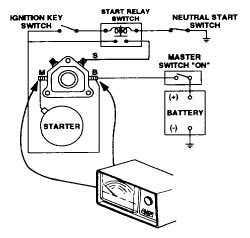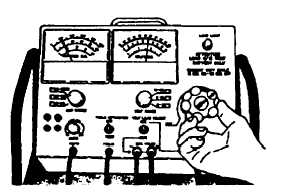| |
TM 10-3930-671-24
b)
Voltage above 9.6 volts. If the voltage stays
above 9.6 volts:
(1)
Be sure all battery connections are clean
and tight.
(2)
Test the current draw of the starter.
Connect an ammeter and carbon pile
battery load tester in parallel with the
battery terminal of the starter solenoid and
ground
(frame
or
battery
negative
terminal). Be sure that the tester, is
turned OFF.
Clip-on inductance tester may be used.
(3)
Increase the load (current) until the same
voltage is reached as measured when
cranking the engine. Note the ammeter
reading. Turn OFF the load. The
ammeter reading indicates the cranking
system current draw.
(4)
Compare the measured system draw with
the typical current requirements of the
diesel engine lift truck system.
Typical starter current draw: 180-220 amps.
c)
Low current means high circuit resistance.
Clean connections or replace wiring.
(1)
If the current draw is low, measure the
voltage drops in the starter motor circuit
(see Starting System Electrical Checks)
while cranking the engine. Large drops of
over 0.4-1 volt indicate the need to clean
and tighten connections or replace wiring
in that portion of the circuit.
(2)
Use volt-drop test to find source of high
resistance.
d)
High current means high drag resistance.
(1)
If excessive current is observed, then
either a poor engine condition exists, such
as tight rings, tight bearings, or lack of
lubrication, or the starter motor needs to
be removed and repaired. The starter
motor
should
be
checked
for
tight
bearings, pole shoe rubbing, and shorted
or grounded armature or field coils.
(2)
Use torque wrench to measure force
required to turn engine over.
Nothing Happens When Start Attempt Made
1.
If the starter motor won’t crank the engine, it may
be simply a poor electrical contact that is the
problem. Loose or corroded battery connections
can slow down or stop a starter motor. A loose
connection may allow enough current to pass to
operate some electrical accessories but not the
starter motor.
2.
The problem may be either a defective or
discharged battery.
3.
The problem may be an open circuit, loose
connection, or other defect in the starter motor,
solenoid switch, starter relay, neutral start
switch, ignition switch, or the wiring.
4.
The best procedure in diagnosing this type of
starting problem is to systematically check the
possible trouble points, starting with the easiest.
See following procedures.
F-300
|



